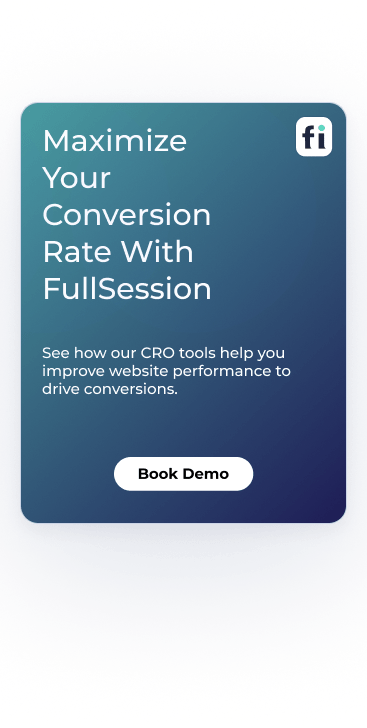FullSession vs. Hotjar Heatmaps: Which Wins for SaaS? ...

Customer Journey Tracking: How to Map Your Customer’s Path to Conversion
We all know that it’s essential to track website conversion rates, but what about monitoring customer journeys on your website? With a comprehensive customer journey map, you can identify potential obstacles and optimize your website accordingly.
In this article, we will go in-depth about the different methods you can use to map customer journeys.
We will also explain how to use FullSession, our user behavior analytics tool, and its features, such as session recordings and replays, interactive heatmaps, and customer feedback, to map customers’ journeys quickly and efficiently.
Start a Free Trial to Experience FullSession
Discover how FullSession user behavior analytics help you capture the entire user journey and visualize and improve each step in your sales or marketing funnel.
What is Customer Journey Tracking?
Understanding how your customers go from observers to promoters will help you create a more personalized experience, which is why you should start mapping their journeys as soon as possible. Let’s start with the basics.
Customer journey tracking helps you monitor all digital interactions between customers and your business. That journey starts when customers first interact with your company (visit the website, sign up for newsletters) and ends when they stop all activities.
It is an excellent way to analyze your customers’ engagement with your company and learn more about retaining them longer and increasing customer lifetime value.
Why Is Customer Journey Tracking Important?
Customer journey mapping is essential because it gives you a unique perspective and helps you optimize and maximize your marketing efforts.
To understand how customers interact with your brand, it is necessary to track their journey from beginning to end. By mapping out the customer’s path to conversion, identifying customer touchpoints and increasing conversions becomes much easier.
Additionally, customer journey tracking can help you identify areas where the customer may drop off in your marketing funnel, allowing you to make necessary changes to your marketing strategy. To track the customer journey effectively, it is essential to collect data from various sources, such as web analytics, customer surveys, and sales data.
You can use this data to create a customer journey map that helps you understand the customer’s experience and make improvements.
Benefits of Customer Journey Tracking
There are many benefits of customer journey tracking. Businesses can optimize their marketing and sales efforts to meet customer needs better. Companies can build stronger relationships with their customers by learning how they interact with their products and services.
Here’s a quick list of other customer journey mapping benefits you might not have thought of before:
- Creating a better experience for your customers
- Providing more accessible content
- Personalizing products and services
- Increasing customer retention
- Creating a more user-friendly website
- Making marketing efforts more targeted and effective
- Receiving accurate retargeting insights
- Learning more about your customer base
- Accelerating sales cycle
- Increasing profits and revenue
- Identifying problem areas and pain points
- Increasing customer loyalty
Why Use Customer Journey Analytics?
As you know, customer satisfaction is essential to success. Happy customers are more likely to return and recommend your company to others. Therefore, it is necessary to understand the customer journey, from first contact to post-purchase follow-up. That is where customer journey analytics comes in.
By tracking customer behavior and interactions across touchpoints, you can gain valuable insights into what works and what doesn’t. You can then use this information to improve and personalize the customer experience.
In today’s competitive marketplace, customer journey analytics is essential for any business that wants to stay one step ahead of the competition.
How to Map Your Customer’s Path to Conversion
Mapping your customer’s path to conversion is a great way to optimize your website and improve your marketing strategy. By understanding your customers’ steps to make a purchase, you can make the process as smooth as possible. So, let’s get started!
1. Establishing business goals
Establishing business goals gives you and your sales and marketing teams a clear idea of what you want to achieve.
Without setting business goals, you won’t be able to effectively track the success and effectiveness of your customer journey maps. Undefined business goals cause a lot of confusion and stress for companies. Here’s what you need to focus on:
- Implement a performance management system
- Define each goal
- Define key performance indicators
- Allocate resources
- Establish a timeline
2. Identifying touch points and critical moments
The first step is to identify the customer’s entry point into the journey. With the first touchpoint, the customer begins engaging with your company through social media, Google searches, referrals, or other sources.
Once you’ve identified the entry point, you can track the customer’s journey through your sales funnel. It will help you see where customers are dropping off and identify potential roadblocks.
When you have a clear understanding of the customer journey, you can start to make improvements that will lead to more conversions.
3. Tracking and analyzing data
Tracking and analyzing data is a significant part of customer journey mapping. It allows you to get a precise insight into what your customers are doing and how your optimizations are performing.
You can track and analyze user behavior with tools like FullSession that monitor all user activity on your website, web app, or landing page and provide you with statistics and visual data that help you understand your customers better.
FullSession offers session recordings and replays, interactive heatmaps, customer feedback, and analytics, which are extremely important for keeping track of customer journeys. You can try FullSession for free, or stay tuned to learn more about each feature.
4. Scoring the performance of customer journeys
Scoring the performance of customer journeys helps you pinpoint which customers require more attention and which conversion efforts aren’t working.
You can assign each customer a journey performance score to see how profitable their interaction with your business is. You should define the score using different metrics that showcase the experience at various touchpoints and the value you receive from each customer experience.
For example, one of the metrics can be the Net Promoter Score, which calculates the customer satisfaction level of your business. You get this score by surveying customers about that experience and breaking down the results to see the average impression.
What Are User Behavior Tools?
User behavior tools help you understand how visitors interact with your website. By tracking user clicks, scrolling, and other interactions, these tools can provide valuable insight into what users are looking for and where they may be having difficulties.
You can then use this information to improve the user experience and optimize the customer journey by changing your website’s layout, content, or navigation. Your team can also use user behavior tools to identify potential security risks or detect fraud.
By understanding how users interact with a site, user behavior tools can help you keep your website safe and user-friendly.
How to Use FullSession for Customer Journey Tracking
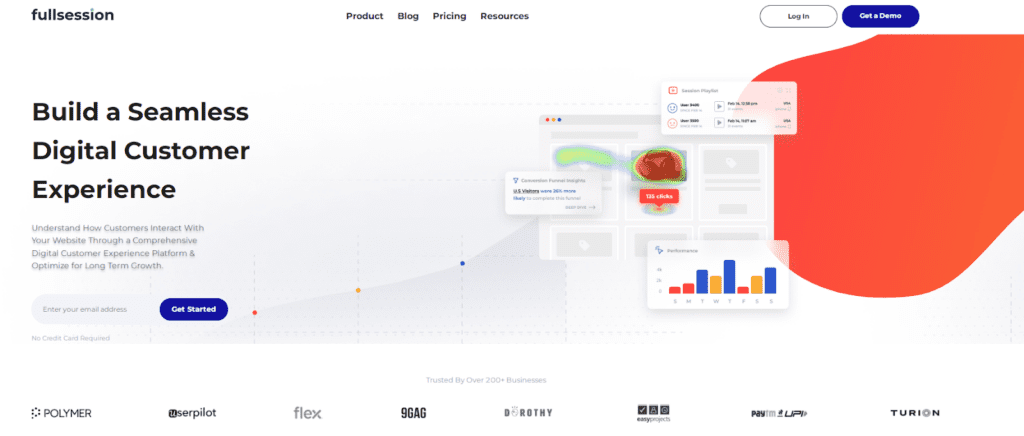
FullSession is your best friend when it comes to customer journey analytics. We offer a full suite of user behavior tracking tools – session replays and recordings, interactive heatmaps, conversion funnel analysis, error tracking and customer feedback forms.
Our user behavior tools also include comprehensive analytics that helps you monitor behavior flow and receive actionable insights about how your customers interact with your website. Tools like FullSession are imperative in any customer journey mapping process.
They give you a clear idea of what needs to be improved and which elements are working or not. FullSession helps you identify challenging areas on your website that impact your customers’ purchasing decisions.
Visualize, Analyze, and Optimize with FullSession
See how to transform user data into actionable insights for peak website performance.
1. Behavior flow
Here’s how FullSession can help with your customer journey mapping efforts.
By combining all of FullSession’s features and incorporating them into your customer satisfaction strategy, you will get a unique overview of your customers’ behavior flow. Identifying the behavior flow is crucial because it gives you a visual map of how your customers behave while on your website.
For example, let’s say that you have a big sale button on your homepage just below the fold. You’ll see how many customers scroll past it, click on it, or ignore it altogether by tracking the behavior flow.
Or, if you have a new collection, the behavior flow will help you identify whether your customers prioritize it over existing items.
Keeping track and noting down these bits and pieces of customer behavioral information helps you create a better offer and speeds up the process of turning window shoppers into customers.
2. Session recordings and replays
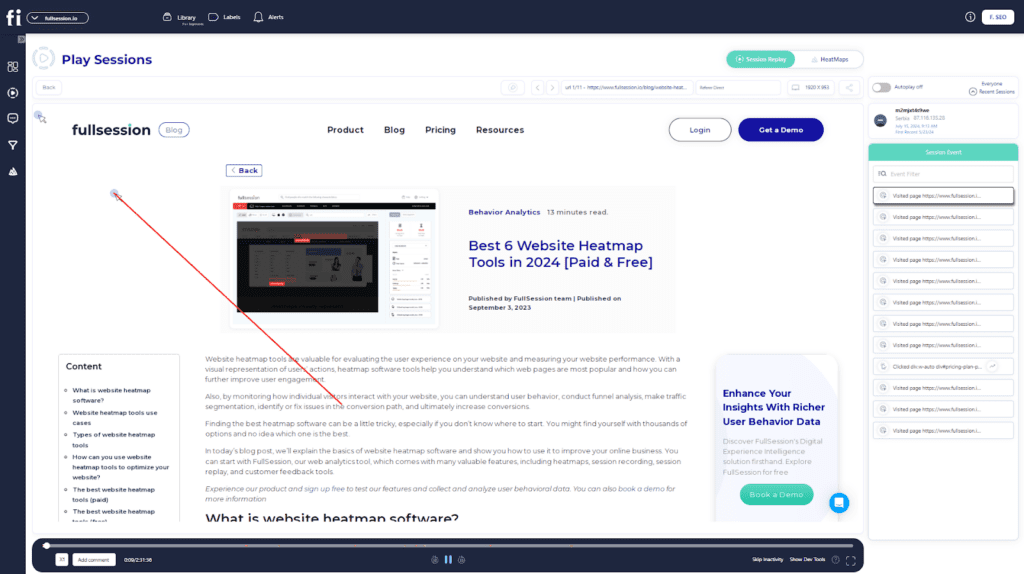
Session recordings are the embodiment of customer journey mapping.
FullSession session recording and replay feature records every click, move, and action the user takes while on your website.
You can install FullSession with a couple of clicks, and our software will automatically record the user activities across the whole website, web app, or landing page.
Customer behavior is predictable as long as you gather enough information while they browse your website. People shop in patterns. These patterns are important because they allow you to be proactive with your marketing strategy and stay ahead of your customers.
Our session recording tool helps you do just that.
You can replay user sessions as many times as you want. That is particularly useful if you notice a lot of users bouncing off your website.

Replaying a couple of user sessions can help you spot the issue causing an increase in the bounce rate, allowing you to fix it and prevent further losses.
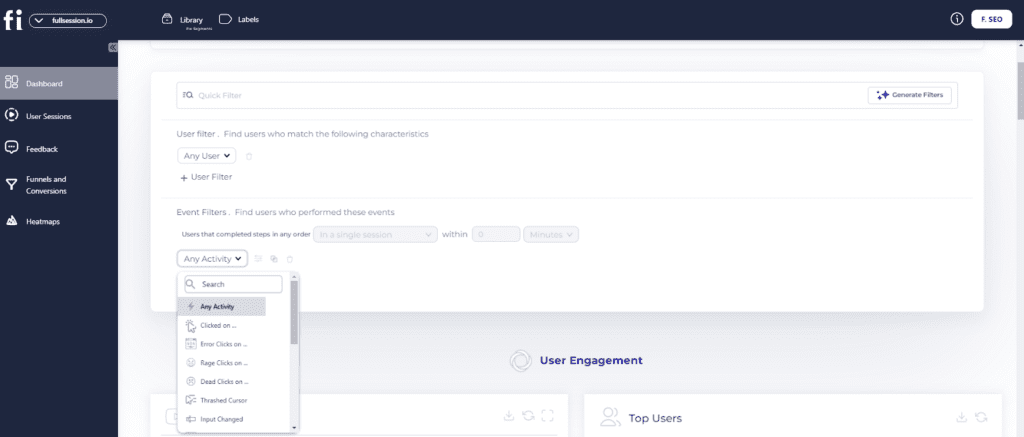
Our team has also added advanced user and event filtering options to complement session recordings and make navigation more accessible and more convenient. You can segment sessions by any activity you’re interested in, such as:
- Browser type
- Email address
- Operating systems
- IP address
- Referrer URL
- Clicked text
- Dead clicks
- Thrashed cursor
- Abandoned forms
- Page load speed
3. Interactive heatmaps
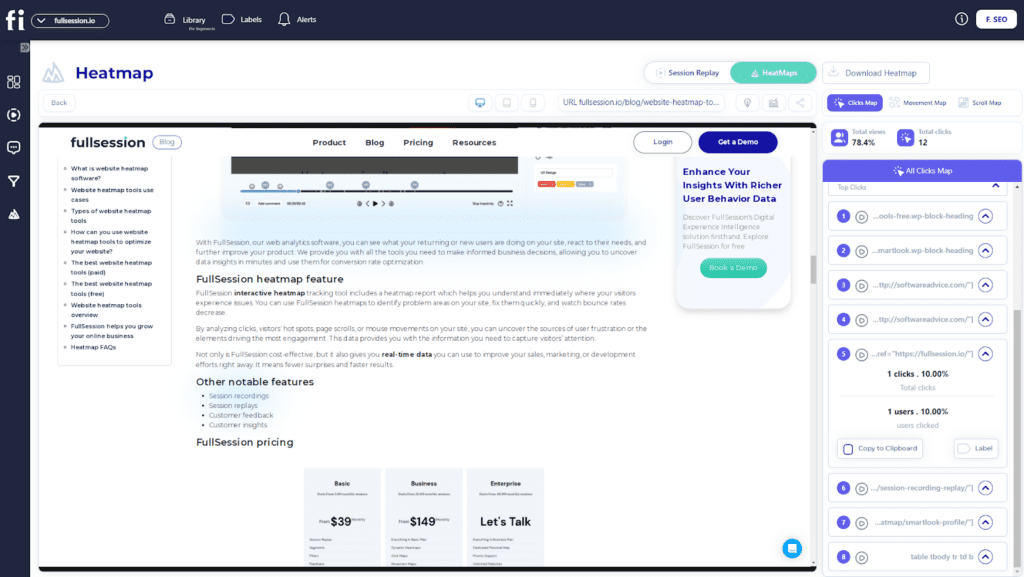
Heatmaps create a graphic overview of the most and least popular elements and sections of your website, web app, or landing page. With FullSession, you’ll get access to click, mouse movement and scroll heatmaps.
A heatmap represents this data in a color-coded system where warm colors (orange-yellow-red) represent popular areas users frequently interact with, while cold colors (blue-green) represent areas users often overlook or completely ignore.
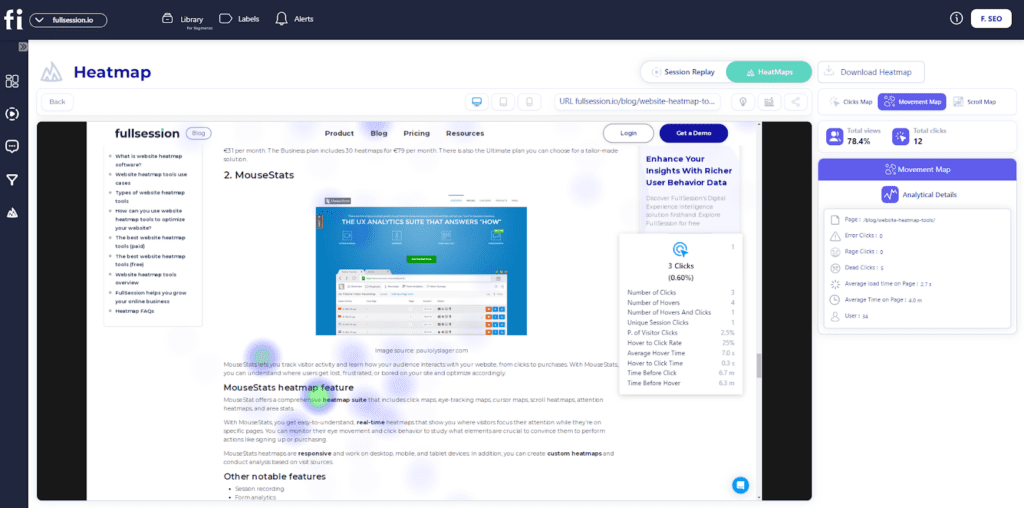
What sets FullSession’s heatmap feature ahead of competitors is that it’s interactive and doesn’t slow down your website, unlike other similar tools like Hotjar.
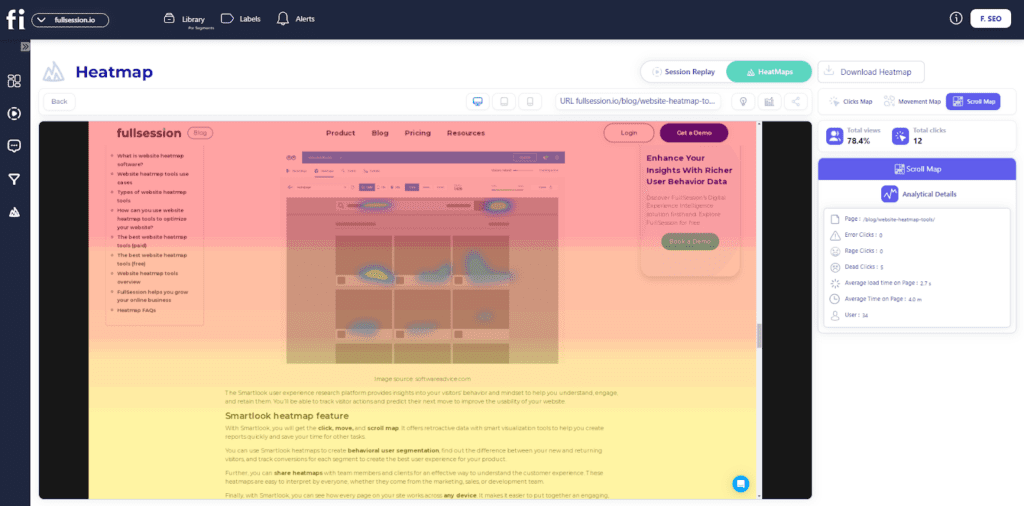
Besides static, it also lets you track dynamic elements like pop-ups, drop-down menus, and hidden items. It relays this information in real time, meaning you’ll be able to analyze an interaction as soon as it happens.
4. Customer feedback
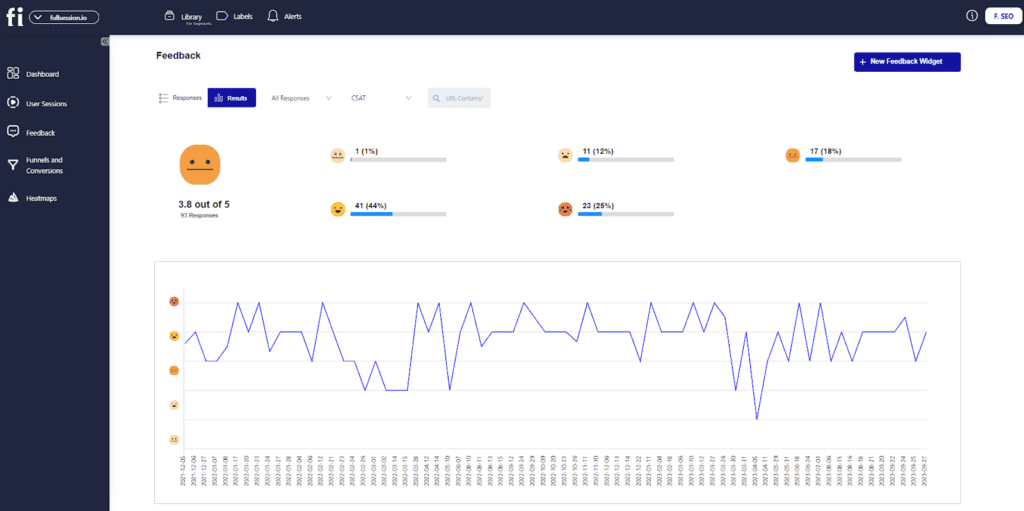
Feedback forms are a great way to find out what bothers or impresses your customers directly from them. They remove the need for any guesswork because they gather information straight from the source.
You can use the FullSession customer feedback feature to create pop-up forms and other types of surveys.
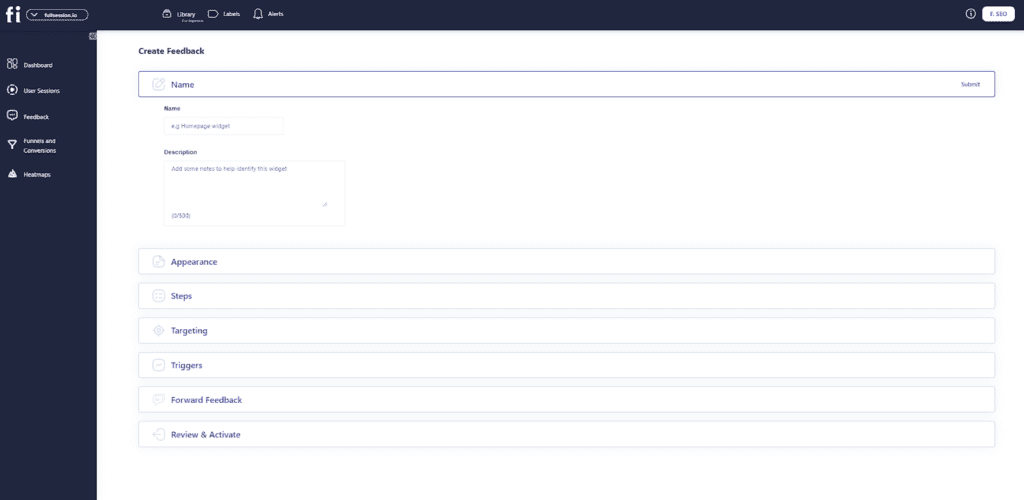
You can also watch a session recording connected to the feedback to understand what happened during the user’s session.

You can set up different triggers that prompt the survey to appear and enjoy a visual overview of the results. For example, if a customer is about to exit the website, you can set up a trigger and ask them about their experience on your website.
With the FullSession user behavior suite, the options are endless, and you can create attractive customer feedback surveys in minutes.
Try FullSession now and see how our tool can help map customer journeys and increase customer satisfaction.
5. Insights
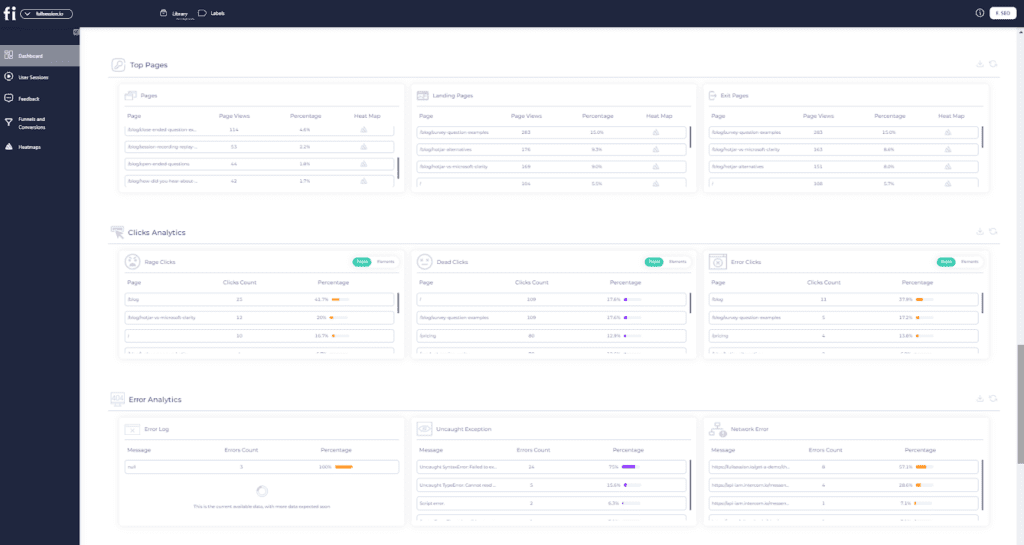
Insight is a handy tool for gathering, sorting, and reviewing different analytics that will help you understand your customer’s journey. The results will indicate what you need to work on and what you need to keep up with.
There are many benefits of using the FullSession insight tool, such as:
- Increasing time spent on the website
- Testing features
- Segmenting and filtering different types of users
- Monitoring user progress
- Discovering errors and pain points
- Improving customer experience
6. Funnels and conversions
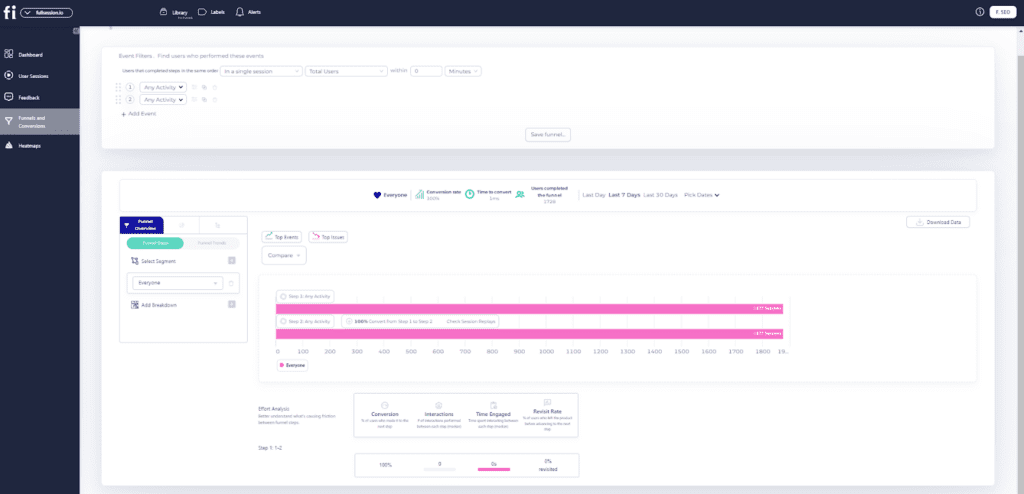
The FullSession Funnels feature offers an in-depth analysis of user journeys, allowing you to monitor, comprehend, and optimize every stage of your conversion funnel.
This tool helps identify crucial actions that drive conversions, detect issues causing drop-offs, and analyze user interactions to improve the overall user experience. Its main features include:
- Funnel steps: Visualize user progression through each funnel step, showing conversion and drop-off rates. Track user movement percentages and compare metrics across segments and time periods.
- Funnel trends: Monitor changes in user flows and conversion rates over time. Spot trends and seasonal variations in user behavior to adjust strategies accordingly.
- Top events: Identify key actions and events boosting conversion rates. Use insights to replicate successful patterns and optimize journeys.
- Top issues: Detect actions or obstacles reducing conversion rates. Implement fixes to reduce friction and enhance the user experience.
- Time engaged: Measure user interaction time between funnel steps to understand user effort. Find areas where excessive time indicates frustration or complexity.
- Top engaged: Analyze the most engaging funnel steps or features, then improve engaging features to improve retention and conversion.
- Revisit rate: Track users leaving the product before advancing to identify potential issues. Optimize steps to streamline journeys and reduce exits.
- Segment analysis: Compare funnel performance across user segments, such as device type, location, or referral source. Tailor experiences based on segment-specific interactions.
- Time period comparison: Analyze performance over different periods to identify trends. Adjust strategies based on temporal insights to maintain or improve performance.
7. Error analysis
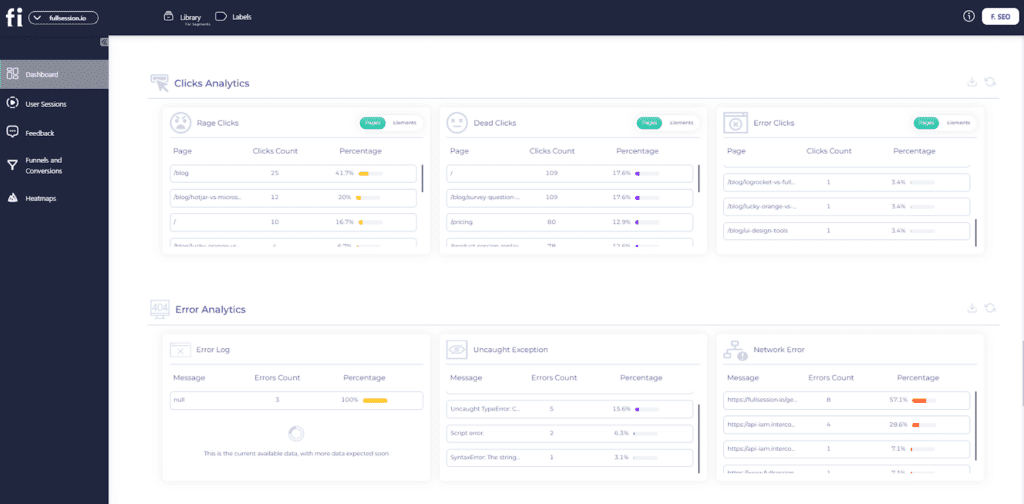
FullSession error analysis helps identify, analyze, and resolve errors impacting user experience by leveraging data on error clicks, network errors, console errors, error logs, and uncaught exceptions.
This feature provides actionable insights to improve the reliability and user satisfaction of digital products.
- Error clicks: Detects non-responsive elements causing client-side JavaScript errors and uses session replays and error click maps to identify and fix issues.
- Network errors: Monitors server request failures due to timeouts, DNS errors, or server unavailability and analyzes error impact by URL, status code, and request method to resolve connectivity issues.
- Console errors: Logs JavaScript error messages and events. It also filters and analyzes errors to identify and fix codebase issues, using session replays for context.
- Error logs: Captures detailed error information, including messages, stack traces, and timestamps, and facilitates accurate debugging and issue resolution for an optimized application.
- Uncaught exceptions: Monitors critical unhandled errors to prevent application crashes and ensures proper error handling and resolution to enhance stability.
- Error trends and segmentation: Segments data by user attributes, session properties, and error types for deeper insights, visualizes error trends and impacts over time to monitor platform health and validate fixes, and integrates session replays to see errors from the user’s perspective.
- Alerts and notifications: Integrates with Slack for real-time error alerts and customizes notifications for various error types, ensuring quick team responses.
FullSession Pricing Plans
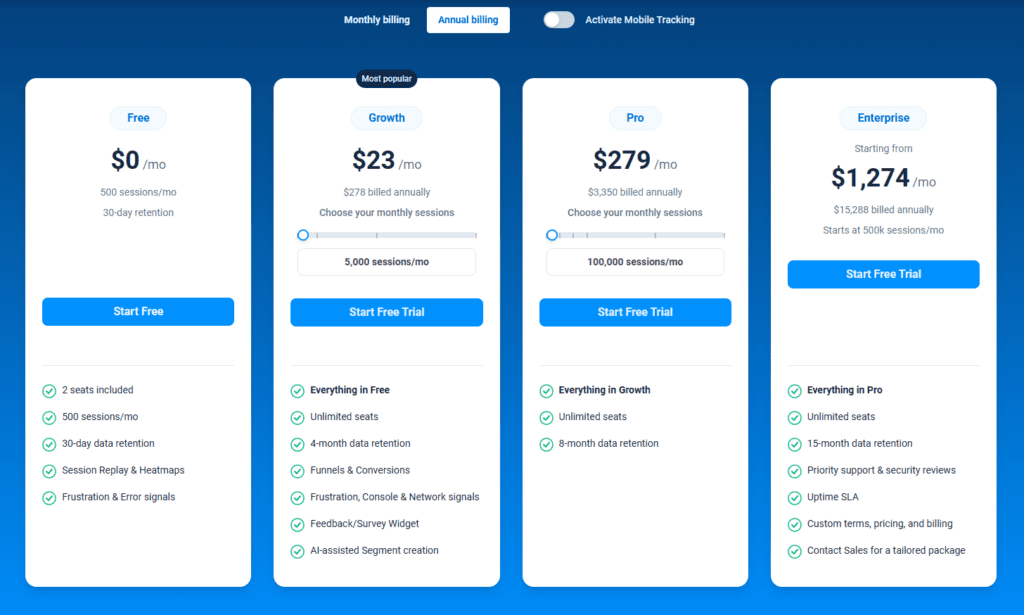
The FullSession platform offers a 14-day free trial. It provides three paid plans—Starter, Business, and Enterprise. You can save up to 20% with a yearly subscription!
Here are more details on each plan.
- The Free plan is available at $0/month and lets you track up to 500 sessions per month with 30 days of data retention, making it ideal for testing core features like session replay, heatmaps, and frustration signals.
- The Growth Plan starts from $23/month (billed annually, $276/year) for 5,000 sessions/month – with flexible tiers up to 50,000 sessions/month. Includes 4 months of data retention plus advanced features like funnels & conversion analysis, feedback widgets, and AI-assisted segment creation.
- The Pro Plan starts from $279/month (billed annually, $3,350/year) for 100,000 sessions/month – with flexible tiers up to 750,000 sessions/month. It includes everything in the Growth plan, plus unlimited seats and 8-month data retention for larger teams that need deeper historical insights.
- The Enterprise plan starts from $1,274/month when billed annually ($15,288/year) and is designed for large-scale needs with 500,000+ sessions per month, 15 months of data retention, priority support, uptime SLA, security reviews, and fully customized pricing and terms.
Create an Effective Customer Journey Map With FullSession
Every customer interacts with a business uniquely, and it’s important to understand how they progress during the journey to optimize their experience.
FullSession is a user behavior analytics platform that assists businesses with mapping customer journeys and identifying opportunities for improvement.
FullSession provides detailed data and analysis on every customer interaction, helping businesses to see where there are potential issues and make changes accordingly.
With FullSession, you can take control of the entire customer journey and improve your overall performance.
Turn User Behavior into Growth Opportunities
Learn how to visualize, analyze, and optimize your site with FullSession.
FAQs About Customer Journey Tracking
What is customer journey tracking?
Customer journey tracking is the process of observing and analyzing the steps a customer takes from the first interaction with a brand to the final purchase and beyond. It helps businesses understand customer behavior and optimize their experience.
What is a customer journey mapping tool?
Customer journey mapping tools collect and visually present customer journey data for easy access and quality insights. These can be user behavior tools, map and chart designing tools, or customer experience solutions.
What are the best customer journey mapping tools?
There are many different customer journey mapping tools on the market that can make your choice very difficult. However, some tools stand out from the rest:
- FullSession
- UXPressia
- Lucidchart
- Microsoft Visio
- Custellence
- Omnigraffle
- Smaply
- IBM Journey Designer
- InMoment
- Asana
- Hotjar
What are the 7 steps to map the customer journey?
- Set clear objectives: Define what you want to achieve.
- Create customer personas: Identify different customer types.
- Identify touchpoints: Map out every interaction point.
- Map the journey: Visualize the steps customers take.
- Identify pain points: Spot areas where customers struggle.
- Analyze data: Use metrics to understand behavior.
- Optimize and improve: Make changes to enhance the experience.
Why do companies use customer journey analytics?
Customer data and journey tracking are vital for understanding how your customers interact with your brand. By mapping out the customer’s path to conversion, you can identify pain points and develop strategies to improve the customer experience.
Analytics is a significant component because it quantifies the experience and gives you the statistical information necessary for any growth strategy.
What are the customer journey stages?
There are five main stages of every customer journey that all marketers and business owners should know:
- Awareness stage
- Consideration stage
- Decision stage
- Retention stage
- Advocacy
How to monitor customer journey?
Use tools like analytics software, heatmaps, and customer feedback to track interactions and behaviors at each touchpoint. Regularly review data to identify trends and areas for improvement.
What are the 4 stages of customer journey mapping?
- Awareness: Customer becomes aware of your brand.
- Consideration: Customer evaluates your product or service.
- Purchase: Customer decides to buy.
- Retention: Efforts to keep the customer coming back.
How do you optimize customer journeys?
You can do that by gathering customer data and analyzing your customer’s experience. For example, let’s say you notice a user frequently visiting your website and looking at products or services but is still not converting.
You would use FullSession session recording and replay tools to see the point at which they decide to exit. You notice that each time they want to add an item to the cart, the previous cart items reset. You can easily conclude that this error causes frustration and that an easy fix can make them convert in minutes.
